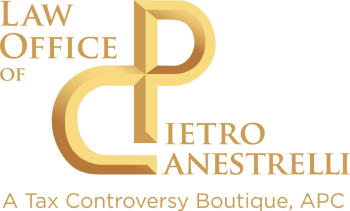Starting a business is an exciting venture filled with promise and possibility. But beyond the product development and branding, one of the most critical steps to long-term success is choosing the right business structure and understanding your small business tax obligations, particularly quarterly estimated taxes. At The Law Office of Pietro Canestrelli, A.P.C., our experienced California tax attorneys help entrepreneurs and established businesses navigate these foundational aspects with confidence and compliance.
Choosing the Right Business Entity
The first step in business formation is deciding what type of legal entity your business will be. This decision has significant implications for liability protection, business tax planning, and administrative requirements.
Sole Proprietorship
A sole proprietorship is the simplest business structure. It is easy to form and operate, with the business and owner being legally indistinguishable. However, this simplicity comes with a drawback: the owner bears unlimited personal liability. Income is reported on the owner’s personal tax return, and self-employment taxes apply.
Partnership
A general partnership involves two or more people who agree to share in the profits and losses of a business. Like sole proprietorships, partnerships pass income and losses to partners who report them on their personal tax returns. Partnerships must file an informational return (Form 1065), but taxes are paid at the individual level.
Limited Liability Company (LLC)
Forming an LLC in California offers liability protection similar to corporations while maintaining the tax flexibility of a partnership. LLCs can be taxed as sole proprietorships, partnerships, or corporations, providing flexibility that can be tailored to your business’s needs.
Corporation (C Corp and S Corp)
C Corporations are separate legal entities that provide robust liability protection and are taxed independently from their owners. However, this structure can lead to double taxation—once at the corporate level and again on shareholder dividends.
S Corporations avoid double taxation by passing income directly to shareholders, but they have strict eligibility requirements and limitations on the number and type of shareholders.
The Importance of Proper Business Formation
Proper business formation in California goes beyond choosing a structure. It involves registering with the appropriate state agencies, drafting and filing formation documents, obtaining an EIN (Employer Identification Number) from the IRS, and complying with ongoing legal obligations such as annual reports and operating agreements.
The Law Office of Pietro Canestrelli, A.P.C. ensures your business entity formation is legally compliant and tax-efficient from day one. Our Temecula tax lawyers and San Diego business attorneys work with clients across California to launch businesses built on strong legal and financial foundations.
Understanding Quarterly Estimated Taxes
Unlike employees who have taxes withheld from their paychecks, business owners are responsible for estimating and paying their own taxes throughout the year. This is done via quarterly estimated tax payments.
Who Needs to Pay Quarterly Taxes?
You generally need to pay quarterly taxes if you expect to owe at least $1,000 in federal income tax for the year, after subtracting your withholding and refundable credits. This often applies to:
- Sole proprietors
- Partners in partnerships
- S corporation shareholders
- Self-employed individuals
- Independent contractors
What Do Quarterly Taxes Cover?
Quarterly tax payments typically cover:
- Federal income tax
- Self-employment tax (Social Security and Medicare)
- Alternative Minimum Tax (AMT)
- Additional taxes on certain investment income (e.g., Net Investment Income Tax)
When Are Quarterly Taxes Due?
The IRS requires estimated payments according to the following schedule:
- April 15 for income earned January 1 through March 31
- June 15 for income earned April 1 through May 31
- September 15 for income earned June 1 through August 31
- January 15 (following year) for income earned September 1 through December 31
How to Calculate Quarterly Taxes
Safe Harbor Method
This method bases your payments on the previous year’s tax liability. If you paid 100% (or 110% for higher-income taxpayers) of last year’s tax liability in quarterly installments, you can avoid penalties even if your income increases this year.
Actual Income Method
This approach involves estimating your income, deductions, and credits for the current year and paying taxes based on those projections. While this can result in more accurate payments, it requires careful recordkeeping and projections.
State Quarterly Tax Obligations in California
In addition to federal taxes, California requires quarterly estimated tax payments for individuals and businesses. The Franchise Tax Board (FTB) enforces payment deadlines and may impose penalties for underpayment. Businesses operating in multiple states may face differing requirements, making multistate tax planning essential.
Bookkeeping and Tax Recordkeeping
Accurate bookkeeping is key to successful quarterly tax planning. Maintain clear records of all:
- Income and business expenses
- Receipts and invoices
- Payroll and contractor payments
- Estimated tax payments
Using accounting software or hiring a bookkeeping professional can help streamline this process. A proactive approach ensures better forecasting, on-time payments, and audit defense preparedness.
Tax Deductions and Credits for Small Businesses
Proper business formation also sets the foundation for claiming key small business tax deductions and credits. These might include:
- Home office deduction
- Vehicle and mileage expenses
- Startup cost deduction
- Health insurance deductions
- Retirement contributions (e.g., SEP IRA, Solo 401(k))
Explore more about individual and business tax credits.
What If You Miss a Quarterly Payment?
Missing or underpaying a quarterly estimated tax payment can result in:
- IRS penalties and interest
- Increased audit risk
- Accumulated debt
If you fall behind, it’s critical to act quickly. Make a payment as soon as possible and consult a business tax lawyer to recalculate your estimates. If necessary, our team can help with IRS penalty abatement or setting up an IRS payment plan.
Why Work With a California Tax Attorney for Business Formation and Quarterly Taxes?
While CPAs handle compliance and filing, a tax attorney provides legal insight into long-term tax strategy and risk management. With The Law Office of Pietro Canestrelli, A.P.C., you receive:
- Expert guidance on business entity formation in California
- Tax planning for small businesses
- Assistance with IRS forms, EIN applications, and corporate bylaws
- Representation in audits and IRS negotiations
As former IRS agents, our attorneys bring insider knowledge to your corner.
Conclusion: Build a Solid Foundation With Expert Guidance
Launching a business involves more than passion—it requires smart legal and financial planning. Choosing the right structure and meeting quarterly tax obligations are vital for sustainability and growth.
With experienced guidance from The Law Office of Pietro Canestrelli, A.P.C., you can launch your business with confidence and peace of mind. We serve clients from our Temecula and San Diego offices, helping them stay compliant and strategic in their tax planning.
Contact our office today to schedule a consultation and take the first step toward legal and tax confidence for your business.




